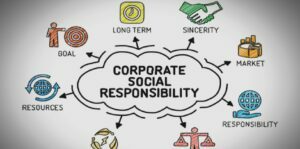Employee engagement refers to the emotional and intellectual commitment of employees towards their work and organization. It is the extent to which employees are passionate about their work and feel valued in the organization. Engaged employees are more productive, loyal, and committed to achieving the goals of the organization. In this article, we will discuss the 10 CS of Employee Engagement that can help organizations improve their employee engagement levels and boost their overall performance.
Contents
- 1 10 CS of Employee Engagement
- 1.1 Clear Communication
- 1.2 Career Growth Opportunities
- 1.3 Compensation and Benefits
- 1.4 Connection with Colleagues
- 1.5 Contribution to The Organization
- 1.6 Celebrating Achievements
- 1.7 Collaboration and Teamwork
- 1.8 Coaching and Mentoring
- 1.9 Culture of Inclusion and Diversity
- 1.10 Corporate Social Responsibility
- 2 Conclusion
10 CS of Employee Engagement
The 10 CS of employee engagement is as follows:
Clear Communication

Clear communication is a fundamental element of employee engagement. It involves ensuring that employees understand what is happening in the organization, what their roles and responsibilities are, and what is expected of them. Clear communication can take many forms, including regular updates from management, open-door policies, and regular meetings with supervisors.
Clear communication can help employees feel valued and engaged because it shows that management is committed to keeping them informed and involved in the organization. It also helps employees understand how their work contributes to the overall goals and mission of the organization, which can increase their sense of purpose and motivation.
Career Growth Opportunities
Career growth opportunities are an important aspect of employee engagement because they provide employees with a sense of purpose and motivation to perform at their best. Employees want to feel that they have opportunities to learn and develop new skills, take on new challenges, and advance in their careers.
Providing career growth opportunities can take many forms, including training and development programs, mentorship and coaching, job rotations, and opportunities for promotion. By investing in these types of programs, organizations can help employees acquire new skills and knowledge, increase their confidence and job satisfaction, and ultimately contribute more to the organization’s success.
Organizations can also offer career growth opportunities by providing employees with clear career paths and progression plans. This can include identifying specific skills and experience needed to advance to the next level, providing regular feedback and performance evaluations, and offering promotions and raises based on merit.
Compensation and Benefits
Compensation and benefits are critical aspects of employee engagement because they play a significant role in attracting and retaining talented employees. Fair and competitive compensation and benefits packages are essential to help employees feel valued and appreciated by the organization.
To ensure that employees are satisfied with their compensation and benefits packages, organizations need to offer fair and competitive pay, benefits, and perks. This can include salaries, bonuses, health insurance, retirement plans, paid time off, and flexible work arrangements.
Compensation and benefits packages can also be customized to meet the needs of individual employees. For example, some employees may prefer a flexible work schedule or more vacation time, while others may value retirement benefits or health insurance.
Connection with Colleagues

Connection with colleagues is an important aspect of employee engagement because it helps employees feel a sense of community and belonging in the workplace. When employees feel connected to their colleagues, they are more likely to be satisfied with their jobs and committed to the organization.
To foster connections between colleagues, organizations can create opportunities for team-building activities, social events, and informal interactions. This can include activities such as team lunches, after-work happy hours, or volunteer events.
In addition to creating opportunities for socializing, organizations can also encourage collaboration and teamwork. By promoting collaboration and providing opportunities for employees to work together on projects and tasks, organizations can help employees build stronger connections with each other.
Contribution to The Organization
Contribution to the organization is a critical aspect of employee engagement because employees want to feel that their work is meaningful and that they are making a difference in the organization’s success. When employees feel that their contributions are valued and recognized, they are more likely to be satisfied with their jobs and committed to the organization.
To foster a sense of contribution, organizations can provide employees with clear goals and objectives that align with the organization’s mission and values. This can help employees understand how their work contributes to the organization’s overall success and give them a sense of purpose and direction.
In addition to setting clear goals and objectives, organizations can also provide regular feedback and recognition to employees for their contributions. This can include performance evaluations, regular check-ins with managers, and public recognition of achievements.
Celebrating Achievements
Celebrating achievements is an important aspect of employee engagement because it helps employees feel valued and recognized for their contributions to the organization. Also, Celebrating achievements can take many forms, including public recognition, awards, and incentives.
One way to celebrate achievements is by recognizing employees for their accomplishments publicly. This can be done through company-wide emails, social media posts, or announcements at team meetings. Recognizing employees in this way can help them feel appreciated and valued by the organization, which can increase their engagement and commitment.
Another way to celebrate achievements is by providing awards or incentives to employees who have demonstrated exceptional performance. This can include bonuses, promotions, or other types of recognition. Providing these types of incentives can motivate employees to continue to perform at their best and contribute to the organization’s success.
Collaboration and Teamwork

Collaboration and teamwork are important aspects of employee engagement because they help employees feel connected to their colleagues and invested in the organization’s success. When employees work together towards common goals, they are more likely to be satisfied with their jobs and committed to the organization.
To promote collaboration and teamwork, organizations can provide opportunities for employees to work together on projects and tasks. This can be done through cross-functional teams, regular team meetings, or project-based work. By working together, employees can share their expertise and knowledge, learn from each other, and contribute to the organization’s success.
In addition to providing opportunities for collaboration, organizations can also encourage open communication and provide resources that support teamwork. This can include training on effective communication, tools for collaboration, and team-building activities.
Coaching and Mentoring
Coaching and mentoring are important aspects of employee engagement because they provide employees with opportunities to learn, grow, and develop in their careers. Also, Coaching and mentoring can take many forms, including one-on-one meetings with managers, peer mentoring, and formal training programs.
Coaching involves providing employees with feedback and guidance to help them improve their performance and develop their skills. This can be done through regular one-on-one meetings with managers, where employees can receive feedback on their work and discuss their goals and objectives. By providing coaching, managers can help employees identify areas for improvement and provide the support they need to achieve their goals.
Mentoring involves pairing employees with more experienced colleagues who can provide guidance and support in their careers. Mentors can help employees develop their skills, expand their networks, and navigate challenges in the workplace. Mentoring relationships can be formal or informal and can be facilitated through a variety of programs or initiatives.
Culture of Inclusion and Diversity
A culture of inclusion and diversity is an important aspect of employee engagement because it helps employees feel valued and respected for their unique perspectives, experiences, and backgrounds. When employees feel included and appreciated, they are more likely to be satisfied with their jobs and committed to the organization.
To foster a culture of inclusion and diversity, organizations can prioritize diversity and inclusion in their hiring processes and policies. This can include training and education programs for managers and employees on topics such as unconscious bias and cultural sensitivity.
Organizations can also create employee resource groups or diversity and inclusion committees to promote diversity and inclusion within the workplace. These groups can provide opportunities for employees to connect with colleagues from diverse backgrounds, share their experiences, and provide input on policies and practices.
Corporate Social Responsibility

Corporate social responsibility (CSR) is an important aspect of employee engagement because it demonstrates the organization’s commitment to making a positive impact on society and the environment. When employees feel that the organization they work for is making a positive impact on the world, they are more likely to be satisfied with their jobs and committed to the organization’s success.
To promote CSR, organizations can engage in a variety of activities, such as volunteering, charitable giving, and sustainability initiatives. This can include organizing volunteer events for employees, donating to charitable organizations, and implementing sustainable practices within the workplace.
In addition to promoting CSR initiatives, organizations can also communicate their CSR efforts to employees and the broader public. This can be done through company-wide emails, social media posts, or public relations campaigns. By communicating their CSR efforts, organizations can build trust and credibility with employees and customers.
Conclusion
Employee engagement is a critical factor in the success of any organization. By focusing on the 10 CS of Employee Engagement, organizations can create a workplace that fosters engagement, productivity, and overall success. By prioritizing these areas, organizations can create a positive work environment that attracts, retains, and motivates talented employees.
Employee wellness programs are the key to improving employee motivation, productivity, and retention. At MantraCare, we have a team of health experts, counselors, and coaches who serve corporate employees with 10+ well-being programs including EAP, Employee Diabetes Reversal, Corporate MSK, Employee Fitness, Corporate Yoga, and Employee Meditation.
